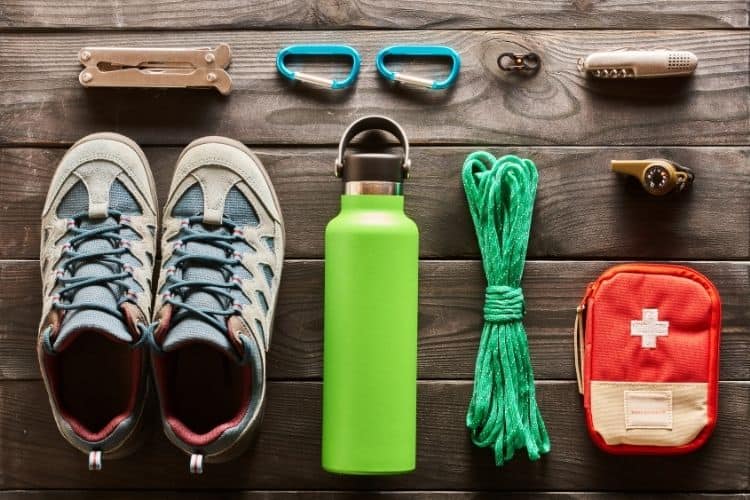
Editor’s Note: We share travel destinations, products and activities we recommend. If you make a purchase using a link on our site, we may earn a commission.
Easing pandemic restrictions and warmer, sunny weather combine to invite more outdoor activity, especially hiking. AllTrails, the largest hiking and trail-specific navigation app, reported hikes and hikers spiked last year by triple digit percentages. Experts predict hiking popularity will remain high.
While everyone is ready to get outside, not everyone is prepared to meet the common challenges of hiking, specifically climate, animal life, exhaustion, dehydration, high-altitude illness and getting lost.
The following hiking tips will address these challenges.

Hiking Tips from the Pros
“The American Hiking Society recommends everyone pack the ‘Ten Essentials’ every time they head out for a hike,” said Brian Hamilton, founder of Skyblue Overland and Global Rescue Safe Travel partner.
“Whether you plan to be gone for a couple of hours or several months, make sure to pack these items, which consist of life-saving gear: navigation, sun protection, insulation, illumination, first aid, fire, repair kit, nutrition, hydration and emergency shelter. Become familiar with these items and know how to use them.”

Dave Keaveny, medical operations specialist at Global Rescue, advises hikers to read the mountain and the weather. “Listen to your gut. Have a plan B and do not be ashamed to turn around. The mountain will be there tomorrow,” he said.
He is right. Getting to the top is optional, getting back is mandatory. Most trail-walkers are aware of the basic hiking and backpacking safety tips. First, let a friend or family member know where you are going and when you expect to return.

Next, bring a cell phone or satellite communications device with you. Three, choose a well-defined hiking trail. Next, wear proper clothing and footwear. Finally, stay hydrated.
You can find the best selection for hiking clothing and footwear at Sierra Trading Post. Check out their gear and deals here.

Top Hiking Injuries
The three most frequent hiking injuries are dehydration, ankle and foot trauma, and hypothermia.
“Dehydration occurs when you use or lose more fluid than you take in, and your body doesn’t have enough water and other fluids to carry out its normal functions,” said Keaveny. “Be sure not to overhydrate before or during your hike so you don’t wash out important electrolytes. Replacing and maintaining electrolytes is just as important as replacing and maintaining hydration.”
Ankle and foot trauma includes tendonitis, sprains, ankle rolls, strains, dislocations and fractures. Beginning hikers are not always used to the distance of a hike or the extra weight of a backpack, making them prone to tendonitis, an inflammation of the tendon.
Coreen Kreutzer is a nurse and mountain medicine expert and recommends new hikers should take shorter steps when going uphill, use hiking poles, and reduce backpack weight if necessary to continue.
Grab the ultimate backpack for your needs and travel conditions at Mountain Warehouse. From camping gear to hiking pants, you can find it all here.
Hypothermia can occur at almost any temperature or in any environment. Mild hypothermia is when your core body temperature dips to 90-95 degrees Fahrenheit. The early signs include someone quieter than normal or delayed response. Each member of your hiking group must pay attention to one another.

Hiking Location Considerations
Regional hiking has specific risks. If you are hiking in the upper elevations of the U.S., Europe, or elsewhere, then trekkers must acclimate and stay hydrated, especially for any trails above 10,000 ft/3,000 m.
If you are trail walking in Central Europe or the Northeast U.S. then be wary of ticks since those regions have the highest tick infection rates. Ticks can transmit diseases such as Elrichosis, Lyme disease and Rocky Mountain spotted fever. After the hike, “check yourself and your fellow hikers for ticks on skin,” Keaveny said.
If you are trekking in the southern states of the U.S. or the southwestern parts of Europe then keep alert of snakes. “Most injuries occur when people try to kill or move the snake,” Keaveny said. “If you see one, give it plenty of room and either go around or turn around.” Staying on the trail is safest since it will give you time to see the snake, assess the situation and wait at a safe distance for the snake to leave.
Hiking, trekking and enjoying the outdoors is wonderful — but failing to prepare and protect yourself can lead to problems ranging from mild discomfort to life-threatening disaster. If you are going to take a hike then follow these safety pro hiking tips. You will not regret it.
Author Bio: Ed Viesturs is a member of the Global Rescue Mountain Advisory Council and the only American to have climbed all 14 of the world’s 8,000+ meter peaks, and the fifth person to do so without using supplemental oxygen.
- Top 5 Spots for Stargazing in North Carolina - April 15, 2024
- The Low-Key Magic of Ghent, Belgium - April 15, 2024
- Swiss Travel: A Guide to Exploring Switzerland by Train - April 15, 2024
